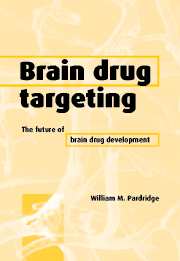Book contents
- Frontmatter
- Contents
- Preface
- List of abbreviations
- 1 Drug targeting, drug discovery, and brain drug development
- 2 Invasive brain drug delivery
- 3 Lipid-mediated transport and carrier-mediated transport of small molecules
- 4 Receptor-mediated transcytosis of peptides
- 5 Vector discovery: genetically engineered Trojan horses for drug targeting
- 6 Linker strategies: the engineering of multifunctional drug formulations
- 7 Protein neurotherapeutics and peptide radiopharmaceuticals
- 8 Antisense neurotherapeutics and imaging gene expression in vivo
- 9 Gene therapy of the brain
- 10 Blood–brain barrier genomics
- References
- Index
- Plate section
5 - Vector discovery: genetically engineered Trojan horses for drug targeting
Published online by Cambridge University Press: 08 January 2010
- Frontmatter
- Contents
- Preface
- List of abbreviations
- 1 Drug targeting, drug discovery, and brain drug development
- 2 Invasive brain drug delivery
- 3 Lipid-mediated transport and carrier-mediated transport of small molecules
- 4 Receptor-mediated transcytosis of peptides
- 5 Vector discovery: genetically engineered Trojan horses for drug targeting
- 6 Linker strategies: the engineering of multifunctional drug formulations
- 7 Protein neurotherapeutics and peptide radiopharmaceuticals
- 8 Antisense neurotherapeutics and imaging gene expression in vivo
- 9 Gene therapy of the brain
- 10 Blood–brain barrier genomics
- References
- Index
- Plate section
Summary
Introduction
Brain drug-targeting vectors are peptides, modified plasma proteins, or peptidomimetic monoclonal antibodies (MAbs) that are ligands for blood–brain barrier (BBB) endogenous receptors (Pardridge, 1986; Kumagai et al., 1987). This property enables these molecules to act as “transportable peptides” and undergo receptor- or absorptive mediated transcytosis through the BBB in vivo. Endogenous peptides or peptidomimetic MAbs undergo receptor-mediated transcytosis (RMT) through the BBB and lectins or cationized proteins such as cationized albumin are transported through the BBB via absorptive-mediated transcytosis. These transportable peptides may be used as molecular “Trojan horses” to ferry drugs across the BBB via the endogenous peptide receptor transport systems. A chimeric peptide is formed when a drug, that is normally not transported through the BBB, is conjugated to a BBB transport vector or “transportable peptide” using linker strategies outlined in Chapter 6. Endogenous peptides that are ligands for BBB RMT systems could be used as vectors, and these are discussed in Chapter 4. In addition, peptidomimetic MAbs can be used as BBB brain drug-targeting vectors provided these MAbs bind the endogenous BBB peptide receptors. This binding enables the MAb to act as a “transportable peptide” and to undergo RMT through the BBB in vivo. For example, either insulin (Fukuta et al., 1994) or an insulin receptor peptidomimetic MAb (Wu et al., 1997b) has been used to deliver chimeric peptides through the BBB. The ability of MAbs to mimic the action of an endogenous peptide was demonstrated in the 1980s (Beisiegel et al., 1981; Soos et al., 1989).
- Type
- Chapter
- Information
- Brain Drug TargetingThe Future of Brain Drug Development, pp. 126 - 154Publisher: Cambridge University PressPrint publication year: 2001
- 2
- Cited by



